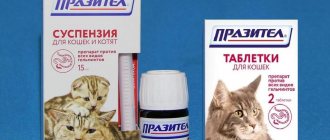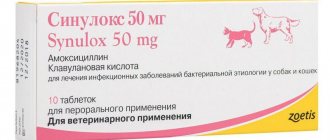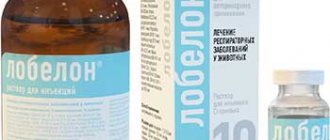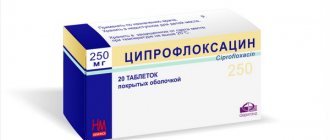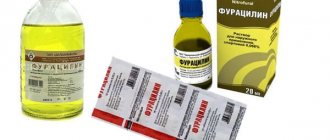What is metronidazole?
Metronidazole is used primarily as an antidiarrheal medication for cats.
It is effective against several protozoal infections, including Giardia, Trichomonas and Balantidium coli parasites, as well as anaerobic bacterial pathogens. Metronidazole may also be prescribed to relieve inflammation of the intestinal tract. Because the drug can cross the blood-brain barrier and bone, it is sometimes used to treat infections of the central nervous system, bones, and teeth.
How to use
Regardless of the dosage form, the standard dosage of the antibiotic is 10 mg/kg. This dose may be adjusted by your doctor depending on the severity of the disease, symptoms, general health, and the presence of chronic diseases. On average, an adult cat requires a fourth or fifth of the tablet. The drug should be given to animals 2 times a day. It is advisable that the interval between doses be 12 hours. The duration of the course is usually 5-7 days, but sometimes the treatment can be increased by the doctor if the disease is severe.
Note! Tablets containing 500 mg of the active substance are not used to treat cats, since it is not possible to calculate the correct dose. Intravenous injections are given only for severe illnesses
Usually the duration of treatment is 3 days, and then tablets are used. For skin diseases, Metronidosal ointment is applied to the affected areas in a thin layer. The veterinarian should provide detailed recommendations for use.
Intravenous injections are given only for severe illnesses. Usually the duration of treatment is 3 days, and then tablets are used. For skin diseases, Metronidosal ointment is applied to the affected areas in a thin layer. The veterinarian should provide detailed recommendations for use.
Most often, tablets are used for treatment. They can be mixed into food, but usually cats voluntarily refuse such treats. It is not advisable to forcefully place the medicine on the root of the tongue, since the bitter taste may cause increased salivation and even foam. The best way to give Metronidazole to a cat is:
- Crush the required amount of tablet into powder.
- Dilute the powder with a small amount of water.
- Feed the animal with the resulting solution. Use a syringe without a needle for this.
- Afterwards, offer your pet clean water.
The powder is used in the same way, that is, before use it is diluted with clean water. The effectiveness of the drug does not depend on food intake
It is important to adhere to the treatment regimen prescribed by your veterinarian, since missed doses may negatively affect the therapeutic effect of the medication.
Metronidazole dosage for cats
Metronidazole dosage varies in cats
depending on its intended use and the specific treatment of the patient. The dose range for oral metronidazole in cats is 7.5 to 25 mg/kg. Higher doses may be given once daily, while lower doses are usually given twice daily. Always follow the dosing instructions provided in your pet's medication prescription and contact your veterinarian with any questions or concerns.
For giardiasis in cats, metronidazole is given to cats at 17 mg/kg every 24 hours for 8 days (1/3 t per cat). Immunomodulatory doses of metronidazole for cats 5-7.5 mg/kg 1-2 times a day for 6-8 weeks (orally or parenterally).
Recommendations from experts
To avoid serious health problems for your pet, you should regularly prevent parasite infestation.
Cats, especially those that go outside, are prone to developing enterobiasis, head lice, fleas and other pests. Metronidazole may not always help cats, so at the first symptoms of infection, you should contact a veterinarian for appropriate help.
If your pet has diarrhea and is unable to visit a doctor, you can give the drug to your pet yourself, but only after correctly calculating the dose. Even if the symptoms stop after this, you still need to seek advice from a specialist.
Metronidazole can be stored at temperatures from -10 to +40 without loss of therapeutic properties, the main thing is not to leave the medication in open sunlight and with free access to children. You can purchase the drug at any pharmacy at an average cost of 25 rubles.
Side effects of metronidazole
Because Metronidazole crosses the blood-brain barrier, neurological side effects are possible with this drug. This usually occurs when pets are given larger doses than recommended or when they are on long-term therapy, especially if they are malnourished or suffering from liver dysfunction. Signs of neurological side effects for metronidazole include:
- Depression and confusion
- Unstability while standing or walking
- Unusual eye movements
- Head tilt
- Ataxia
- Seizures
- Immobility
Other possible side effects of metronidazole in cats include:
- Allergic reaction (difficulty breathing, hives, etc.)
- Drooling and vomiting (the drug is very bitter)
- Vomit
- Loss of appetite
- Diarrhea
- Lethargy
- Blood in the urine or dark urine
- Liver damage
Medicines that react with metronidazole:
Contraindications
Frequent parasitic infections in cats are a direct indication for the use of this remedy. Pathogenic microorganisms and bacteria can disable the entire body, manifesting itself in infectious disorders, inflammation, the formation of ulcers in the digestive tract, edema and even gangrene. Due to the harmful effects of parasite waste products on animal tissues and organs, a number of characteristic unpleasant symptoms may occur. To eliminate the painful manifestations of parasitic effects, veterinarians can prescribe Trichopolum to a cat with diarrhea.
In what cases is Trichopolum prescribed to cats:
- Postpartum anaerobic infections;
- Manifestations of dysentery;
- Diarrhea;
- With balanthiosis;
- For trichomoniasis;
- In the presence of malignant edema;
- For aphthous stomatitis;
- For gingivitis;
- During necrobacteriosis.
Trichopolum is an influential antibiotic that has a broad effect on the animal’s body. Because of this, treatment of cats with Trichopolum is possible only after obtaining the results of laboratory analyzes of biomaterials and identifying a parasitic individual.
Contraindications for the use of this drug include:
- Liver failure;
- Pregnancy;
- Lactation period;
- Kittens are up to 8 months old.
How you give Trichopolum to your cat will determine whether side effects will occur. Undesirable manifestations may occur if the permissible dosage for the cat has been exceeded or the duration of treatment has been prolonged.
The instructions for use contain contraindications for Metronidazole, which also apply to cats. Stop using the drug in the following cases:
- For liver failure. Since the drug is metabolized in the liver, the load on the organ increases, which can cause complications. In addition, the body will not be able to cope with the removal of the medication from the body.
- In case of intolerance to components. In this case, allergic reactions occur. They can be mild or cause anaphylactic shock.
- During pregnancy. There have been no formal studies of the drug in this group of animals, but it is believed that it may have an effect on the development of offspring.
- During lactation. The components of the drug easily penetrate into the body of the offspring through mother's milk. The drug can suppress the kitten's immune system, which can cause life-threatening infections.
Metronidazole rarely causes side effects in animals. In addition to allergic reactions, other health problems are sometimes observed:
- disorders of the digestive system;
- depression;
- lack of appetite;
- irritability, etc.
Important! Metronidazole has the ability to suppress the immune system, so during treatment it is necessary to reduce the likelihood of contracting infections. It is advisable to isolate the pet from other animals and limit its stay on the street.
Metronidazole is the active ingredient of a drug called Trichopolum. The mechanism of action is based on the fact that the nitro groups of the substance block the synthesis of DNA of microbial cells. However, not all microorganisms are sensitive to the substance. The drug is most active against Giardia, Amoeba, Trichomonas, Balantidia, Histomonas, the causative agent of feline leishmaniasis, and some gram-negative and gram-positive microorganisms. The drug is also indicated for surgical infections.
Sometimes metronidazole is prescribed for “safety net”, in “company” with other antibiotics, but such a load on the body of a cat or dog is unreasonably high.
Experienced veterinarians resort to prescribing metronidazole only in extreme cases. But owners of dogs and cats, as well as breeders, very actively give this drug to animals. Unfortunately, the instructions for using the drug are not always read to the end by animal lovers; moreover, the recommendations are simply ignored. The use of this drug is not always beneficial for the animal. Often owners treat a symptom, for example, diarrhea, but the disease itself remains undiagnosed and becomes chronic.
In case of overdose, nystagmus (rhythmic movement of the eyeball), convulsions, and ataxia (impaired coordination of movement) are sometimes observed.
https://youtube.com/watch?v=7ErilJsTdmo
Drug interactions
- Cimitidine
- Cyclosporine
- Warfarin
- 5-fluorouracil
- Phenytoin
- Phenobarbital
There are several drugs available to treat giardiasis in cats, including metronidazole.
The purpose of this study was to determine whether metronidazole benzoate, administered at a dose of 25 mg/kg, orally, twice daily for 7 days, reduces or eliminates shedding of Giardia cits in cats with chronic infection. Twenty-six adult, laboratory-reared cats were used in this study. Sixteen cats were orally infected with cysts of the human giardiasis pathogen Giardia sp. The remaining ten cats were infected with the same Giardia sp. presumably due to contamination from an adjacent room where cats were studying the Giardia vaccine. A fecal sample was collected from each cat within 1 week of initiation of treatment and then every 2 to 4 days for 15 days after completion of treatment. Fecal samples were analyzed for the presence of Giardia cysts using a commercially available direct immunofluorescence (IFA) test. No clinical signs of drug toxicity were detected during the study.
Always rule out intestinal parasites for gastrointestinal diseases in cats. Treatment of giardiasis with oral administration of metronidazole.
Parasites should always be considered in any patient with chronic GI signs. Veterinarians often prescribe empirical anthelmintics such as fenbendazole or pyrantel. Giardia is usually diagnosed using proper stool examination techniques. In cats, Giardia lives in the lower small intestine (dogs in the upper intestine), and signs can often be associated with colitis-like signs in the large intestine. The treatment of choice for many years has been metronidazole. Metronidazole 15–25 mg/kg orally once or twice daily for seven days is currently recommended. Neurologic signs with metronidazole toxicity occur at higher doses (>30 mg/kg/day), so proper dosing is critical.
^Top
Veterinarian recommendations
The body of animals, including cats, is very susceptible to a variety of parasites. For this reason, regular preventive measures against worms are required.
In the event that at a certain stage of treatment with Metronidazole there are suspicions of the presence of enterobiasis, it is necessary to simultaneously treat for parasites, change the way of life and diet.
The fact is that while walking along the street, a cat can become infected with many diseases, and it must be removed from others for a while and kept absolutely clean.
We also recommend that you read our other article: Worms in cats: symptoms, causes and treatment methods
Analogs
In the absence of metronidazole, broad-spectrum antibiotics can be used:
One of the most important storage conditions is to avoid exposure to UV rays, because the medicine begins to decompose under the influence of the sun, its qualities are lost, and it becomes dangerous. The optimal temperature for storage is no more than 20 degrees.
The medicine is yellow. When excreted from the body, urine takes on an orange tint. Tablets with a bitter, unpleasant taste. Therefore, it is necessary to give the animal the medicine so that it cannot taste it. It is recommended to have an assistant for such an operation, because cats can show aggression and scratch strongly.
Use our advice wisely, and let your furry pet always be healthy!
In this informational article, you can find answers to frequently asked questions about pets and one of the well-known drugs that are often used to solve certain problems with their health.
Do not forget about the need to visit a veterinarian with your pet, since only he can help make an accurate diagnosis and give answers to frequently asked questions from those who really want to cure their pet, and not make it worse, which is not uncommon when self-medicating on home.
Metronidazole for cats dosage, instructions for use, indications and contraindications
Cats are given Metronidazole based on the diagnosis and severity of the disease, but generally it is 8–10 mg/kg of animal weight every 12 hours.
This drug is mixed with food or administered forcibly.
Veterinarians recommend its use for diseases such as: - anaerobic infections after childbirth; - malignant edema; — Disinterry; - Trichomonosis; - Balantiosis; - Diarrhea; - Gingivitis; — Aphthous stomatitis; — Necrobacteriosis; — Necrotizing mastitis; — Enterotoxemia.
In addition, Metronidazole gel or ointment can be used externally for skin diseases that were caused by anaerobic organisms.
This antibiotic is contraindicated in pregnant and lactating cats, animals with liver failure, and allergies to the components of the drug.
Metronidazole for cats with diarrhea, cystitis, how to give, dose, dropper, price
Medicine for a cat for diarrhea can be given as follows: crush half a tablet, add a little water and pour it through a syringe into the cat, or administer it intravenously through a dropper, only if the disease is acute, dripped for no more than three days, using bottles of medicine, after which you should switch to pills. Only the veterinarian determines the dosage.
Metronidazole solution 5 mg/ml 100 ml costs 50 - 1600 rubles, and there are 250 tablets in a pack. can be purchased for about 270 - 300 rubles, a jar of 1000 tablets costs 1550 rubles.
Metronidazole for animals composition and pharmacological properties, side effects
Metronidazole contains 25% of the active substance. The tablets are white or with a greenish or yellowish tint, the weight of such a tablet is 0.25 g.
Metronidazole is an antibiotic that is used in the fight against Trichomonas, Giardia, amoebae, histomonas, etc. It is also prescribed for tetanus and various inflammatory processes.
When used orally, this drug is well absorbed and enters organs and tissues from the digestive tract and accumulates in the liver. It is excreted from the body in urine, feces, and partially enters milk, so milk should not be used for food within 36 hours after using Metronidazole.
Side effects include an allergic reaction, nausea, and sometimes the central nervous system is affected (manifested by convulsions, ataxia, etc.)
Metronidazole for animals release form and storage, special instructions
Metronidazole is available in the form of tablets packaged in a box of 250 pieces, or white or yellowish powder, packaged in 100, 150, 250, 500, 1000 g.
Metronidazole should be stored in a dry, dark place where children and animals cannot reach, away from food and food, the optimal temperature is considered to be from -10 to 40°C. If the conditions are met, the drug can be stored for 24 months.
After using the drug, it is not allowed to eat milk and meat of treated animals. The slaughter of animals and birds is allowed after: five to seven days after a course of Metronidazole.
Application and dosage of the drug
For cats of any age, Metronidazole is prescribed for diagnosed diseases such as:
- giardiasis and histomoniasis;
- dysentery, diarrhea (with severe diarrhea);
- anaerobic postoperative infections, including after obstetric procedures;
- ulcerative gingevitis;
- trichomoniasis and balantiosis;
- necrotizing mastitis and necrobacteriosis.
The required amount of medicine is calculated based on the weight of the animal, according to the proportion - 10 mg of the active substance per 1 kg. However, the attending physician can change this treatment regimen based on specific symptoms and the general condition of the patient.
For cats, tablets are most often used, divided into several parts. The duration of taking the drug is most often 5–7 days. In some cases, intravenous administration of a medicinal solution may be prescribed. On average, after injections for 3 days, the animal is switched to tablets.
The tablets are easiest to mix into their daily food, but many cats will not eat this mixture. The bitter taste of the medication may make it difficult to forcefully administer the medication by placing part of the tablet on the base of the animal's tongue.
It is most rational to use the following algorithm of actions:
- Grind a measured amount of the drug into powder.
- Dissolve the medicine in 3-5 ml of water and draw it into a syringe without a needle.
- Give the cat a drink using a syringe, and then bring it to clean water.
TRICHOMONIASIS OF CATTLE
Cattle trichomoniasis ex. (Trichomonas foetus) occurs in subacute and chronic forms. It manifests itself in cows: abortions in the early stages of pregnancy (3–4 months), vaginitis, metritis, barrenness and a long service period. Manifests itself in bulls: purulent urethritis, balanoposthitis. Without treatment with metronidazole, the disease causes damage to livestock production due to gynecological and andrological problems in cows and bulls.
Spreaders of trichomoniasis in cattle
Sick animals and carriers of the pathogen in the subclinical stage. Transmission of the pathogen by contact during natural mating, or during artificial insemination with sperm containing the pathogen. When deep frozen, Trichomonas can be preserved for years.
The main distributors of the invasion are bulls. In some cases, Trichomonas are spread by test bulls through veterinary instruments (vaginal speculum, artificial vaginas, etc.).
Sources of trichomoniasis - contaminated with Trichomonas:
· discharge from the genitals;
· aborted fetuses and their shells that contaminate surrounding objects;
Signs and clinical picture
The subclinical period varies from several days to two to three months. clinical picture, namely:
hyperthermia up to 41 degrees Celsius;
depressed state, immobility;
There are three main types of the inflammatory process in trichomoniasis:
Vestibulovaginitis manifests itself as swelling, redness of the mucous membranes of the external genitalia with mucus secretion. Palpation reveals pain, nodules the size of a millet grain to a pea. Sometimes, when palpating the mucous membranes of the vulva, multiple fine-bubble roughness is felt. Vaginal discharge from catarrhal to purulent-catarrhal. Prescription of metronidazole and its medications (Metronid-50, Trichopolum, Trichovet, Metrogyl, Metranidazole substance, Klion, Siprogil, Tricho-Pin, Rozex, Trichobrol, Efloran, Deflamon, Batsimex, Metrovit, Metrovagin, Metrolax, Flagyl, Trichosept, Metroxan, Metron) significantly reduces the severity of clinical manifestations of vestibulo-vaginitis.
Symptoms
Fungal conjunctivitis, like any other type, usually develops against the background of decreased immunity, long-term use of steroids or antibiotics. The disease lasts from 7 to 10 days. Fungal conjunctivitis can manifest itself in a number of changes:
Fungal conjunctivitis with complications in a middle-aged woman
- redness, burning in the eye, lacrimation;
- damage to the entire thickness of the mucous membrane up to the cornea;
- sores with green coating;
- purulent lymphadenitis;
- the appearance of unstable gray or yellow membranes;
- ulcers on the cornea.
With granulomatous fungal conjunctivitis, purulent lymphadenitis often develops; fungal micelles can most likely be found in the purulent contents of the lymph nodes. With a longer course, inversion and changes in the edges of the eyelids are possible. When complications occur, the horny environment is affected, causing dacryocystitis and canaliculitis.
Pharmacology / Pharmacokinetics
Mechanism of action/Effect: Metronidazole decreases upon entry into the target cell, interacts with bacterial or protozoal DNA, causing loss of helical structure and strand breaks in DNA; these effects inhibit nucleic acid synthesis and cause cell death.
Absorption: Metronidazole is well absorbed from the gastrointestinal tract of animals. Distribution: Horses - In one equine pharmacokinetic study, peak metronidazole concentrations in abdominal fluid, synovial fluid, and cerebrospinal fluid were 65%, 92%, and 30% of peak serum concentrations. At an oral dose of 7.5 mg/kg every 6 hours, endometrial penetration was poor. Biotransformation: hepatic, metabolized primarily by side chain oxidation and glucuronide synthesis. Pharmacokinetic data are presented below.




